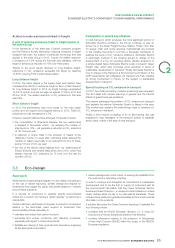APC 2012 Annual Report Download - page 71
Download and view the complete annual report
Please find page 71 of the 2012 APC annual report below. You can navigate through the pages in the report by either clicking on the pages listed below, or by using the keyword search tool below to find specific information within the annual report.
2012 REGISTRATION DOCUMENT SCHNEIDER ELECTRIC 69
SUSTAINABLE DEVELOPMENT
2
SCHNEIDER ELECTRIC’S COMMITMENT TO ENVIRONMENTAL PERFORMANCE
iron, and 34elements have a recovery rate below 1%, including
rare earth elements. The UNEP recommends that priority be given
to product design in order to facilitate disassembly and recovery
of metals at end of life and to emphasize recycling electrical and
electronic equipment (WEEE). Schneider Electric participates in the
recycling systems via the recovery of its own waste, with a target
of 85% in2012, and the End-of-Life Instructions for its products.
Management of waste, emissions and industrial
pollution
Waste
Because waste is a major source of pollution but also a potential
source of raw materials, waste management is a priority in
environmental protection.
Most of Schneider Electric’s waste is solid waste. Continuous
improvement plans have been deployed to manage this waste. This
approach is fully in line with the framework of ISO14001 certifi cation
that all Schneider Electric production and logistics sites worldwide
are required to follow.
The target of the One program 2009-2011 was to recover 85% of
hazardous and non-hazardous waste. In2012, Schneider Electric
confi rmed this objective. Because classifi cation systems vary widely
from country to country, the Group does not consolidate global data
by category (hazardous and non-hazardous). Data is processed to
ensure local traceability. All waste is channeled to the appropriate
treatment facility.
Schneider Electric notes the quantities of waste produced and
recycled on a six monthly basis and monitors this production per
capita, on a like-for-like basis in order to evaluate its performance
from one year to the next.
The overall eco-production approach helped stabilize our production
of waste per capita in2012 compared with 2011 on a comparable
basis and to increase the proportion of waste recycled from 83%
at the end of2011 to 85.7% at the end of2012 on a comparable
basis. This target of 85% was exceeded.
Conditions of use and contamination of soils
Virtually all Schneider Electric sites are located in urban or industrial
areas and do not affect any notable biotopes. None of the Group’s
businesses involve extraction or landfarming.
No substances are purposely released into the soil in the course of
site operation. Workshop fl ooring at risk is given a waterproof seal
using a suitable treatment (resin retention). Hazardous substances
are systematically stored and handled in areas equipped with
retention tanks in compliance with regulations. As a result of
developments in legislation, retention systems are being designed
more and more to compensate in the event of malfunctions or
emergencies, such as fi res.
In2012 Schneider Electric conducted its annual review of pollution
risks at all manufacturing sites as part of ISO14001 tracking. No
major incidents were reported in2012.
Discharge into the water and air
Because Schneider Electric is mainly an assembler, its discharge
into the air and water is very limited. Mechanical component
production workshops are carefully monitored, in keeping with
their ISO14001 certifi cation. Their releases are tracked locally as
required by current legislation. No major spills or discharges were
reported in2012.
Emissions of NOx and SOx and particles into the air are monitored
site by site according to their heating activity; monitoring of these
emissions is verifi ed via ISO 14001 audits. Emissions are then
monitored by the site managers with respect to the thresholds
defi ned in local legislation and monitored by the heads of the
geographical areas (see SERE organization page 61 ). These
emissions are not subject to consolidation at Group level.
The COV emissions have been identifi ed as representative of Group
levels and are therefore included in Group reporting.
Finally, the CFC and HCFC emissions are monitored through our air
conditioners in accordance with legislation. They are not linked to
our industrial activities.
Noise and odors
All Schneider Electric sites comply with noise and odor limits.
Environmental risk management and prevention
The ISO 14001 environmental management system covers
management of environmental risks. No Schneider Electric sites
are Seveso classifi ed. The Group has continued to improve its
knowledge of its sites, mainly certain sites with a long industrial
history, by carrying out detailed analyses of their subsoils. On a
permanent basis, Schneider Electric also carries out voluntary
transactions to prevent discharges into the soil. As a result of all of
these actions, no compensation has been paid out in application of
the legal ruling in2012.
In2011-2012, a particular effort was dedicated to an independent
ground analysis of our oldest industrialized sites. No clean-up
action or rehabilitation has been identifi ed as needing to be carried
out in the short term.
All of the Group’s industrial sites, which are ISO 14001 certifi ed,
have procedures in place to prevent emergencies and respond
effectively if necessary. Preventive and corrective action plans are
based on an analysis of non-standard situations and their potential
impact. This analysis draws in part on hazard reviews for classifi ed
installations.
In France, for example, certain sites that handle large amounts of
chemical compounds, such as Le Vaudreuil, MGA and 38 TEC,
are equipped with balloon-type containment systems to avoid any
pollution through the water systems; others, located next to a river,
have fl oating beams.
Drills are held regularly throughout the year to ensure that supporting
procedures are ready and effective.
A national organization has been set up to track sensitive sites.
Their managers systematically receive training in environmental
crisis management. Directives, procedures and national guidelines
concerning environmental crisis management, historical and
current operations management, pollution risk prevention and other
topics are available on the intranet. Internal audits verify that these
procedures are applied correctly.
See also p. 35-36 for the industrial and environmental risk factors.
























